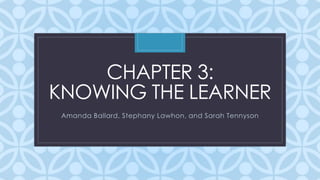
Book Club Presentation
- 1. C CHAPTER 3: KNOWING THE LEARNER Amanda Ballard, Stephany Lawhon, and Sarah Tennyson
- 2. Learning Styles •Helps teacher: •see individual ways students learn and solve problems •know students’ strengths •Helps students: •know themselves •develop metacognitive skills (self-assessment)
- 3. Learning-Styles Model (Rita and Kenn Dunn) •Auditory: spoken material, discussion, songs, stories •Visual: written material, illustrations, diagrams •Tactile: touching and manipulating objects, concrete experiences •Kinesthetic: experience, physical activity, teaching others what they know •Tactile/Kinesthetic: physically involved, role play, simulations, freedom to move around
- 4. Activity Blue Group: Sarah Pink Group: Stephany Yellow Group: Amanda
- 5. Factors that affect learning •Noise Level •Design Structure •Motivation and Persistence •Responsibility •Structure •Grouping
- 6. Thinking Styles Anthony Gregorc •Concrete Random – experimentation •Concrete Sequential – organization and structure, sensory-based evidence •Abstract Sequential – analytical, logical, independent investigation •Abstract Random – emotional, reflection, personalized information
- 7. Thinking Styles David Kolb •Accommodators – creative, out-of-the-box •Convergers – clear goals and timelines, only want to know what’s useful/relevant •Assimilators – dig deep into content, patient •Divergers – caring environments, sense of community
- 8. Thinking Styles Bernice McCarthy •Type 1: Imaginative Learner – personal connection, reflection •Type 2: Analytical Learner – seek facts •Type 3: Commonsense Learner – want to know what’s useful and practical •Type 4: Dynamic Learner – experimentation, self- discovery
- 9. Thinking Styles Silver, Strong, and Perini •Self-Expressive Learner – creative, original/unique ideas •Mastery Learner – step-by-step, learn to master •Understanding Learner – reason and logic to support learning •Interpersonal Learner – personal connections, socialization
- 10. Thinking Styles: Do all of them relate?
- 11. Learning and Thinking Styles: How can we provide for ALL? Turn and Talk!!
- 12. Multiple Intelligences Howard Gardner Linguistic Bodily/Kinesthetic Logical/Mathematical Interpersonal Visual/Spatial Intrapersonal Musical Naturalist Existential
- 13. How are you smart? We can create learning profiles for students through: • Observations • Using a variety of strategies • Student self-evaluation - surveys, questionnaires, etc. • Logs/Journals It is important for teachers to build a repertoire of strategies that meets each child’s unique learning style and intelligence.
- 14. C CHAPTER 4: ASSESSING THE LEARNER Amanda Ballard, Stephany Lawhon, and Sarah Tennyson
- 15. Pre-Assessment Take a post it note and answer the question: What do you already know about pre- assessment? When your finished place the post it on the board.
- 16. Pre-Assessment Pre-Assessment shows the teacher: •What the students already know •What further instruction is needed •What requires re-teaching or enhancement •How to set up flexible groups
- 17. Steps of Pre-Assessment Pretest •Covers whole unit of group •Recall facts •Interpret information (charts, graphs, etc.) •Asks open-ended questions •Asks students to use the information to show another way form or situation.
- 18. Steps of Pre-Assessment Informal Pre-Assessment •Use interest surveys •Demonstrate with manipulatives •Use dialogue to find what students what to learn, and how they feel about the topic
- 19. Steps of Pre-Assessment Rank Scores •Determine appropriate uses of flexible groupings •Form timelines for the unit •Discover the number of students at different levels of mastery
- 20. Informal Pre-Assessment •Squaring Off •Boxing •Yes/No Cards •One Sided •Two Sided •Graffiti Facts
- 21. Surveys •Help teachers: •Know the different learners in their classrooms •Find out students’ prior knowledge and experiences
- 22. Assessment Tools Used DURING Learning •Thumb it •Fist of Five •Face the Fact •Reaching for the Top •Speedometer Reading
- 23. Reflections AFTER Learning •Wraparounds •Talking Topic (Variation A and B) •Conversation Circles •Donut (Variation A and B) •Rotation Reflection •Paper Pass •Draw It! •More Ideas! •Grand Finale Comment
- 24. Portfolios What are they? •A collection of student work for specific purposes •Identify progress •Show evidence of success •Support evaluation and grading •Show what needs to be learned •Help keep track and reflect
- 25. Portfolios Why do we use them? •Richard Striggins suggests that portfolios are like a color video with sound, much more vivid than just a test paper •They support evidence •Students take ownership of their work
- 26. Portfolios How do we use them? •Student-teacher partnership •4 steps in the portfolio process: • Collect • Select • Reflect • Project
- 27. Collect • Collect data throughout the school year Select • Homework • Projects • Written pieces • Tests • Assignments • Videos •Best piece or ”I’m proud of” piece •Work in progress •Student/teacher selection •Most improved or most difficult piece •Special or free choice •Pieces to be deleted
- 28. Reflect Student reflects on •Why piece was selected •What criteria the piece satisfies Project • Students see • where they need improvement • where they can celebrate • growth •Each portfolio is unique and different from the rest, just like the student
- 29. Grading Reasons for grading •Measure content mastery •Chart progress •Motivate students •Provide information to a variety of audiences Ongoing Assessments •Compares pre- and post-performance •Evaluates material studied •Designed to address individual or group
- 30. Authentic Tasks •Students perform tasks in a realistic, real-world context •Demonstration •Presentation •Role-playing Examples?
- 31. Activity How do you make a peanut butter and jelly sandwich?
- 32. Final Grades Grades can be demoralizing towards students •Observable, factual statements Omit adjectives and adverbs •Based on level of competency not compared to rest of the class •Always honor persistence, tenacity, and effort
- 34. Exit Ticket 1. Which of the following is NOT a factor that affects learning? a. Grouping c. Color b. Noise level d. Motivation 2. TRUE OR FALSE? Portfolios help track and reflect. 3. Speedometer, Fist of Five, and Face the Fact are all examples of what type of assessment? a. Assessment during learning c. Reflection after learning b. Portfolio d. Pre-assessment 4. TRUE OR FALSE? Learning styles only affect the teacher. 5. Name at least 4 of Gardner’s 9 Multiple Intelligences.